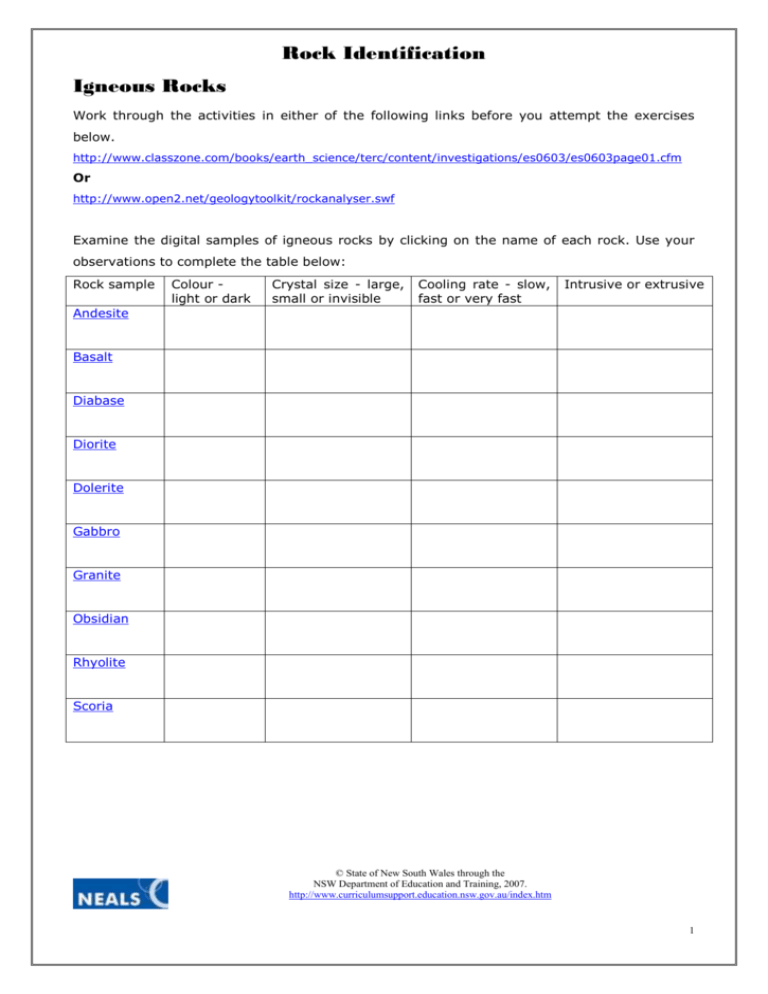Rock Sample Activities
advertisement

Rock Identification Igneous Rocks Work through the activities in either of the following links before you attempt the exercises below. http://www.classzone.com/books/earth_science/terc/content/investigations/es0603/es0603page01.cfm Or http://www.open2.net/geologytoolkit/rockanalyser.swf Examine the digital samples of igneous rocks by clicking on the name of each rock. Use your observations to complete the table below: Rock sample Colour light or dark Crystal size - large, small or invisible Cooling rate - slow, fast or very fast Intrusive or extrusive Andesite Basalt Diabase Diorite Dolerite Gabbro Granite Obsidian Rhyolite Scoria © State of New South Wales through the NSW Department of Education and Training, 2007. http://www.curriculumsupport.education.nsw.gov.au/index.htm 1 Rock Identification Metamorphic Rocks Work through the activities in either of the following links before you attempt the exercises below. http://www.childrensmuseum.org/geomysteries/faq1.html Or http://www.bbc.co.uk/schools/gcsebitesize/chemistry/changestoearthandatmosphere/0rocksrev4.shtml In this activity you will compare the original rocks with their altered (metamorphic) form. Compare each pair of rocks listed below and note similarities and differences between each pair. Metamorphic Rock Similarities Differences Original Rock Sandstone (sedimentary) Quartzite Shale (sedimentary) Slate Limestone (sedimentary) Marble Granite (igneous) Gneiss © State of New South Wales through the NSW Department of Education and Training, 2007. http://www.curriculumsupport.education.nsw.gov.au/index.htm 2 Rock Identification Sedimentary Rocks Read the information about the different classes of rocks by clicking on the class of each rock. Use your understanding to complete the table below. Click on each numbered sample and use the information provided in the table to identify each sample. Rock 1 Rock 2 Rock 3 Rock 4 Rock 5 Rock 6 Rock 7 Rock 8 Rock 9 Rock 10 Class of rock Features Name Sample Number Clastic Chemical Organic Made up of rounded pebbles in a silt and clay matrix Made up of sharp fragments of pebble size in a silt and clay matrix Made up of compacted and cemented sand in layers Made of compacted and cemented silt Made of compacted and cemented silt and clay in layers Grey rock made of microscopic crystals White rock made up of cube-shaped crystals Black shiny rock that can burn White rock made of coral skeletons or shells of sea animals White powdery rock made of microscopic animal shells Conglomerate Breccia Sandstone Siltstone Shale Limestone Rock salt Coal Shelly limestone Chalk © State of New South Wales through the NSW Department of Education and Training, 2007. http://www.curriculumsupport.education.nsw.gov.au/index.htm 3 Rock Identification Syllabus Links SCIENCE Years 7-10 syllabus Outcome 4.9: A student describes the dynamic structure of Earth and its relationship to other parts of our Solar System and the Universe. Students learn about: 4.9.6 the lithosphere Students learn to: identify that rocks are composed of minerals b) explain the breaking down of rocks in terms of physical and chemical changes c) relate the formation of landforms to weathering, erosion and deposition d) describe the origins of sedimentary, igneous and metamorphic rocks. Outcome 4.11: A student identifies where resources are found, and describes ways in which they are used by humans Students learn about: 4.11 natural resources Students learn to: a) distinguish between natural and made resources b) give examples of resources from living things and resources extracted from the air, Earth and oceans c) identify fossil fuels and describe some of their uses © State of New South Wales through the NSW Department of Education and Training, 2007. http://www.curriculumsupport.education.nsw.gov.au/index.htm 4







